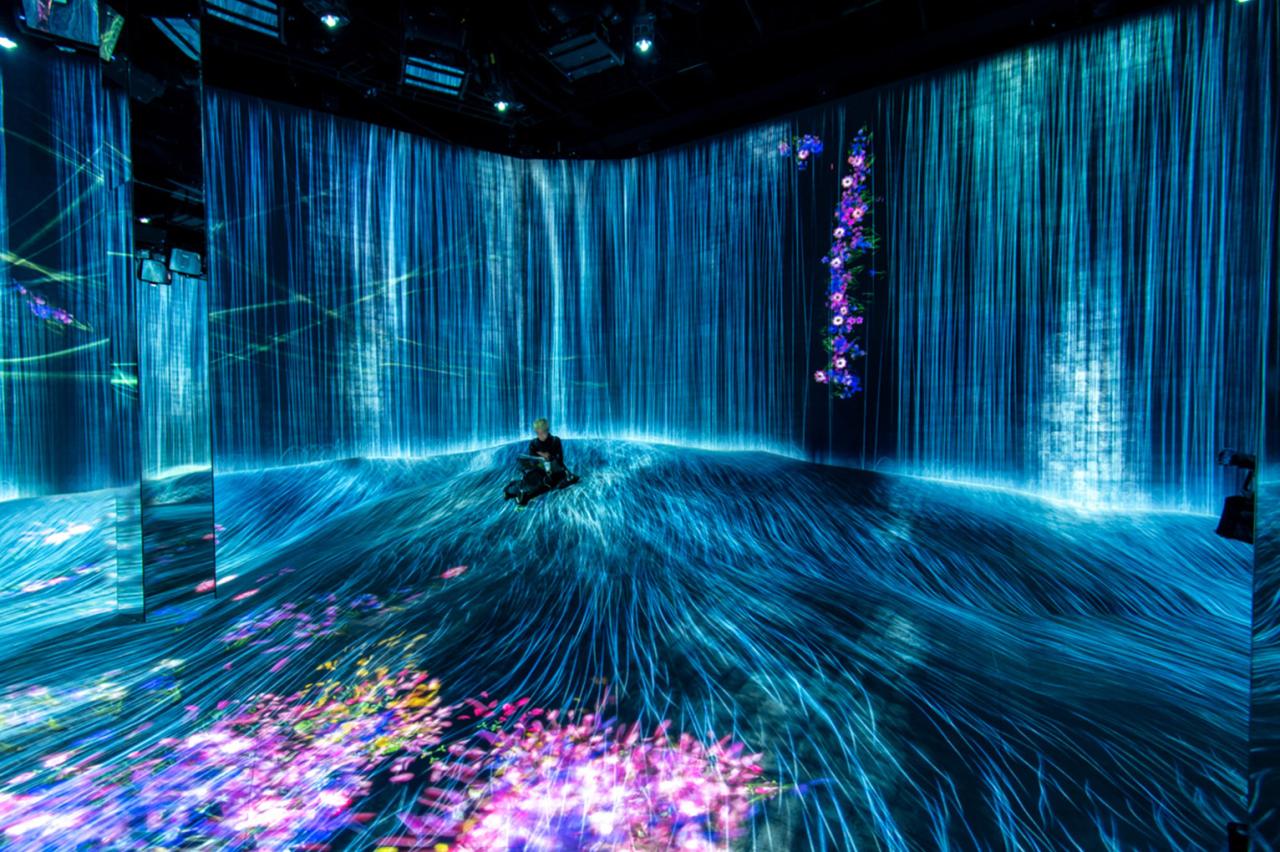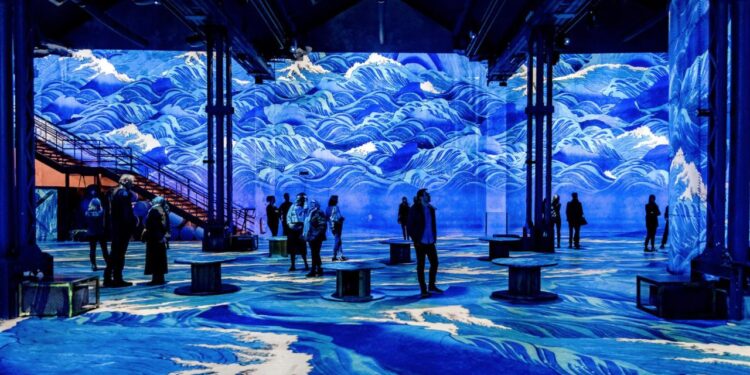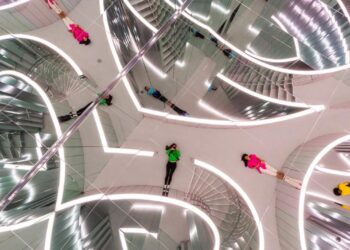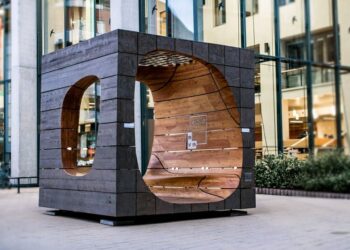In a rapidly evolving world, where digital experiences constantly vie for our attention, the desire for tangible, captivating, and multi-sensory engagement has propelled immersive environments to become a dominant and rapidly growing design trend. Far more than just visually appealing spaces, these environments actively envelop participants, blurring the lines between reality and simulation, and transforming passive observation into active participation. From interactive art installations and dynamic retail spaces to therapeutic healing rooms and expansive virtual worlds, the rise of immersive design signals a fundamental shift in how we conceive, experience, and interact with our surroundings. This comprehensive article delves into the burgeoning popularity of immersive environments, exploring their historical evolution, the profound psychological impact they wield, and their diverse manifestations across various design disciplines. We’ll uncover how designers and innovators are leveraging cutting-edge technologies to craft captivating, memorable, and profoundly transformative experiences that resonate deeply with human needs and desires.
A History of Immersion

The human desire for immersive experiences is not a modern phenomenon; it’s a deep-seated craving for alternate realities and heightened sensory engagement that has manifested in various forms throughout history.
A. Ancient Rituals and Sacred Spaces: From elaborate cave paintings meant to transport participants to spiritual realms to grand temples designed to inspire awe and devotion, ancient cultures understood the power of manipulating environments for immersive experiences. Rituals often involved multi-sensory elements like chanting, incense, and specific visual arrangements.
B. Baroque and Rococo Architecture (17th-18th Centuries): These artistic periods excelled at creating total environments. Churches and palaces were designed with intricate frescoes, grand sculptures, and dramatic lighting that enveloped visitors, aiming to evoke profound emotional and spiritual experiences. The Gesamtkunstwerk (total work of art) concept emerged here, integrating all art forms.
C. Panoramas and Dioramas (19th Century): These large-scale, cylindrical paintings and three-dimensional models offered popular immersive spectacles. Panoramas transported viewers to distant landscapes or historical battles, while dioramas used lighting and sound effects to create realistic scenes, providing an early form of virtual tourism.
D. World’s Fairs and Themed Parks (Late 19th – 20th Centuries): World’s Fairs showcased technological and cultural wonders, often in elaborate, themed pavilions designed to transport visitors to different places or futures. The development of theme parks, pioneered by Disney, perfected the art of creating fully immersive narrative environments with elaborate sets, animatronics, and ride systems.
E. Performance Art and Installation Art (Mid-20th Century onwards): Artists began creating works that physically enveloped the viewer (installation art) or actively involved them in the creative act (performance art and “happenings”). Examples include Yayoi Kusama’s “Infinity Rooms” or Olafur Eliasson’s weather installations, which manipulate perception and sensory input.
F. Early Virtual Reality and Computer Graphics (Late 20th Century): The advent of rudimentary VR headsets and advanced computer graphics in the 1980s and 90s opened the door for true digital immersion, laying the groundwork for today’s sophisticated virtual environments.
This historical journey reveals a continuous human drive to create experiences that transcend passive observation, aiming to fully engage the senses and transport participants into new realities, now dramatically amplified by modern technology.
The Psychological Nexus
The powerful growth of immersive environments is deeply rooted in their ability to tap into fundamental human psychological needs and cognitive processes, offering unique and profound experiences.
I. Heightened Engagement and Presence
A. Flow State Induction: When an environment is truly immersive, it can lead to a “flow state”—a mental state where a person is fully absorbed in an activity. This leads to increased enjoyment, focused attention, and a perception of time distortion.
B. Suspension of Disbelief: Immersive environments are designed to be so compelling that participants temporarily forget their real-world surroundings, fully believing in the presented reality. This allows for deeper emotional and cognitive processing of the experience.
C. Active Participation: Unlike traditional passive consumption (e.g., watching a movie on a screen), immersive environments often require active movement, exploration, and interaction, making the experience more engaging and memorable.
D. Sense of Agency: When participants can influence the narrative or outcome of an immersive experience, it gives them a stronger sense of control and personal investment, leading to greater satisfaction.
Immersive environments foster a profound sense of presence, making experiences feel more real, impactful, and personally relevant.
II. Multi-Sensory Stimulation
A. Holistic Sensory Input: True immersion often engages multiple senses simultaneously—sight, sound, touch, sometimes even smell and taste—creating a richer, more comprehensive, and memorable sensory experience.
B. Emotional Amplification: Engaging multiple senses can trigger more profound and nuanced emotional responses. A combination of visuals, spatial audio, haptic feedback, and even curated scents can evoke specific feelings more effectively than any single medium.
C. Enhanced Memory Encoding: Experiences that involve multi-sensory engagement are more deeply encoded in memory, leading to stronger recollection and a longer-lasting impact.
Multi-sensory integration creates a complete and believable reality within the immersive space, transforming simple observation into a rich, lived experience.
III. Emotional and Cognitive Transformation
A. Empathy and Perspective-Taking: Immersive experiences, particularly those in VR, can put participants directly into someone else’s shoes, fostering profound empathy and allowing for a deeper understanding of diverse perspectives.
B. Learning and Training Effectiveness: Immersive environments provide safe, realistic, and highly engaging platforms for learning and training, leading to faster skill acquisition and better retention, especially for complex or high-stakes scenarios.
C. Stress Reduction and Well-being: Immersive nature experiences (e.g., virtual forests) or calming sensory environments can significantly reduce stress, anxiety, and improve mood, acting as therapeutic tools.
D. Storytelling Reinvention: Immersive environments allow for non-linear, personalized storytelling, where participants uncover narratives at their own pace and influence outcomes, leading to a more personal and impactful narrative journey.
Immersive experiences offer powerful avenues for emotional connection, skill development, and even personal transformation, going far beyond mere entertainment.
The Impact Across Design Disciplines
The principles of immersive design are no longer confined to specialized entertainment venues; they are profoundly reshaping how designers approach spaces, products, brands, and even digital interfaces across diverse industries.
I. Retail and Commercial Design
Retail is transforming into experiential destinations, leveraging immersion to forge deeper connections with consumers.
A. Brand Flagship Experiences: Stores designed as immersive brand journeys, using interactive digital walls, projection mapping, soundscapes, and curated scents to tell a brand’s story and create a memorable, multi-sensory engagement beyond traditional shopping.
B. Phygital Retail: Blending physical retail with digital interaction, such as AR mirrors for virtual try-ons, interactive product displays that react to touch, or gamified experiences that integrate with loyalty programs.
C. Pop-Up Immersive Activations: Temporary, highly Instagrammable immersive spaces designed to generate buzz, provide unique brand interactions, and create shareable moments for marketing campaigns, often with booking systems for timed entry.
D. Experiential Showrooms: Instead of just displaying products, showrooms allow customers to interact with them in simulated real-world scenarios, using VR/AR to visualize furniture in their homes or test drive cars virtually.
E. Dynamic Storefronts: Interactive window displays that respond to passersby, inviting them into the store with captivating visuals, sound, and personalized messaging.
Commercial spaces are becoming destinations for entertainment and engagement, not just transactions, transforming consumption into an experience.
II. Hospitality and Entertainment
Hotels, resorts, and entertainment venues are embracing immersive design to create truly unique and memorable guest experiences.
A. Themed Immersive Hotels: Resorts designed as fully realized themed environments (e.g., a “sci-fi” hotel, an “underwater” resort) where every detail, from room design to dining and staff interactions, contributes to a cohesive narrative, providing an escape from reality.
B. Immersive Dining Concepts: Restaurants that offer multi-sensory dining, where projection mapping transforms tables into dynamic landscapes, soundscapes enhance flavors, and interactive elements surprise and delight diners.
C. Location-Based Entertainment (LBE) Arcades and Parks: Dedicated venues for VR arcades, large-scale interactive escape rooms, and themed immersive attractions that blend physical sets with cutting-edge digital technology, providing collaborative and highly engaging experiences.
D. Personalized Guest Room Experiences: Smart room technology allows guests to customize lighting, temperature, music, and even digital art displays to their preferences, creating a feeling of bespoke luxury and control.
E. Wellness and Therapeutic Immersion: Spa and wellness centers incorporating immersive visuals (e.g., projection of natural scenes), guided soundscapes, and calming scents to enhance relaxation and healing experiences.
Hospitality design is moving beyond comfort to offer guests extraordinary, emotionally resonant journeys that stand out in a competitive market.
III. Museum and Exhibition Design
Museums are transforming from static repositories to dynamic, interactive, and immersive learning environments.
A. Immersive Galleries: Exhibitions that use large-scale projections, sound installations, and interactive elements to transport visitors into historical periods, natural environments, or artistic creations, making learning more experiential.
B. Interactive Digital Exhibits: Hands-on displays, touchscreens, and motion-sensing installations that allow visitors to directly engage with content, manipulate data, and explore topics in a highly personalized way.
C. Virtual Reality Experiences: VR headsets offer visitors the chance to explore ancient ruins, walk through historical events, or examine artworks in virtual 3D space, providing unparalleled access and context.
D. Gamified Learning Paths: Incorporating game-like elements, challenges, and rewards to encourage exploration, deeper engagement, and retention of information, particularly for younger audiences.
E. Data Visualization Installations: Presenting complex scientific or social data through large-scale, interactive, and aesthetically compelling abstract visuals that visitors can manipulate and explore.
Museums are becoming vibrant cultural hubs where visitors are invited to discover, interact, and forge personal, immersive connections with knowledge and art.
IV. Public Spaces and Urban Planning
Immersive principles are increasingly being integrated into public spaces, transforming urban environments into dynamic, interactive landscapes that foster community and well-being.
A. Interactive Public Art Installations: Sculptures or large-scale digital projections that respond to light, sound, touch, or movement from passersby, encouraging spontaneous interaction, play, and unexpected moments of delight.
B. Dynamic Lightscapes and Soundscapes: Curated auditory and visual environments that transform urban areas, creating different moods and experiences at various times of day or for special events, enhancing public engagement.
C. Smart City Interfaces and Augmented Reality Tours: Interactive kiosks, digital signage, and AR apps that provide real-time urban information, historical overlays, or gamified tours, making cities more navigable and engaging.
D. Urban Playgrounds and Experiential Parks: Public spaces designed with interactive elements (e.g., musical swings, light-up pathways, mist installations) that encourage physical activity, creative play, and social interaction for all ages.
E. Biophilic Urban Interventions: Integrating large-scale living walls, immersive green spaces, or urban farms that actively contribute to air quality and biodiversity while providing engaging, multi-sensory natural experiences.
Public spaces are becoming vibrant arenas for shared experiences, fostering a sense of community, wonder, and deeper connection to the urban environment.
V. Health and Wellness Design
The understanding of how environments influence well-being is leading to highly specific immersive designs for health outcomes.
A. Sensory Rooms (Snoezelen Rooms): Multi-sensory environments designed for individuals with developmental disabilities, autism, or dementia, using light, sound, textures, and aromas to stimulate or calm the senses, fostering relaxation and engagement.
B. Immersive Therapy Environments: VR-based therapies for phobias, PTSD, pain management, or rehabilitation, where controlled virtual environments allow patients to confront fears or practice skills in a safe, immersive setting.
C. Healing Gardens and Restorative Spaces: Healthcare facilities are integrating outdoor and indoor gardens, often with specific plant choices, water features, and seating arrangements, designed to provide calming, restorative immersive experiences for patients and staff.
D. Mindfulness and Meditation Pods: Designed with specific lighting, soundscapes, and sometimes tactile elements, these small immersive spaces offer a retreat for relaxation and mental restoration in busy environments.
E. Personalized Sleep Environments: Smart bedrooms that dynamically adjust lighting (to regulate circadian rhythm), temperature, sound, and even subtle scents to optimize sleep quality based on individual biometrics and preferences.
Immersive design in health and wellness focuses on creating therapeutic environments that directly contribute to physical and mental well-being.
Innovations Powering the Immersive Growth

The rapid growth and sophistication of immersive environments are inextricably linked to a convergence of cutting-edge technologies.
A. Advanced Projection Mapping and LED Displays: High-resolution projectors, flexible LED screens, and transparent OLED displays allow for seamless, large-scale visual immersion on almost any surface, creating dynamic and ever-changing environments.
B. Real-time Graphics Engines (e.g., Unreal Engine, Unity): These powerful engines, originally for gaming, enable the creation of incredibly realistic, interactive, and dynamic virtual environments that can be rendered in real-time, blurring the line between digital and physical.
C. Sophisticated Sensor Technologies: Motion sensors, depth cameras (e.g., LiDAR), eye-tracking, biometric sensors, and even brain-computer interfaces (BCI) allow installations to respond intelligently, personally, and intuitively to participants’ presence, gaze, and actions.
D. Artificial Intelligence (AI) and Machine Learning (ML):
* Generative Content: AI can create dynamic, ever-changing visuals, soundscapes, or narratives in real-time based on user input, environmental data, or pre-defined parameters, ensuring unique experiences.
* Personalization Algorithms: AI analyzes user behavior and preferences to adapt the immersive experience in real-time, tailoring content, pace, and interaction to each individual.
* Natural Language Processing (NLP): Powers sophisticated conversational interfaces within immersive environments, allowing users to interact through natural speech, enhancing realism.
E. Augmented Reality (AR) and Virtual Reality (VR):
* Immersive Hardware: Increasingly affordable and powerful VR headsets (e.g., Meta Quest, Apple Vision Pro) and AR glasses are making fully immersive experiences accessible to mass audiences.
* Seamless Integration: AR allows designers to overlay interactive digital content onto real-world spaces, transforming perception without needing fully enclosed environments.
F. Haptic Feedback and Olfactory/Gustatory Technologies: Advanced haptic devices (gloves, vests) can simulate a wide range of textures and sensations, while nascent technologies for controlled scent and taste delivery further enhance multi-sensory immersion.
These technological innovations provide designers with an unprecedented toolkit to create experiences that were once confined to the realm of imagination, making immersive environments a powerful force for transformation in design.
Challenges and The Future of Immersion
While the growth of immersive environments is explosive, their continued evolution presents significant challenges and exciting future possibilities.
A. Cost and Scalability: Creating high-quality, technically sophisticated immersive installations can be very expensive, limiting widespread adoption, especially for permanent architectural integrations.
B. Technological Obsolescence: The rapid pace of technological change means that embedded systems and hardware can become outdated quickly, leading to costly upgrades or rendered obsolete features. Design for modularity and upgradability is crucial.
C. Accessibility and Inclusivity: Ensuring that these experiences are truly accessible to people with diverse abilities (e.g., visual impairments, mobility issues, motion sickness sensitivity) requires thoughtful design from the outset.
D. Data Privacy and Ethics: Installations that collect user data (e.g., biometrics, interactions, gaze tracking) raise major privacy concerns. Robust security protocols and transparent data usage policies are paramount.
E. Sensory Overload and Disorientation: Poorly designed immersive environments can lead to sensory overload, motion sickness, or cognitive disorientation, diminishing the positive experience.
F. Balancing Spectacle and Substance: There’s a risk that the “immersive” aspect becomes a superficial gimmick without deeper artistic, educational, or communicative substance.
Despite these challenges, the human craving for immersive experiences ensures their continued growth.
G. Everyday Immersion: Expect the principles of immersive design to become more integrated into daily life, making our homes, workplaces, and public spaces more responsive, personalized, and engaging in subtle ways.
H. Emotional and Therapeutic Applications: A deeper focus on leveraging immersive design to create environments specifically tailored to enhance well-being, reduce anxiety, aid in therapy, or promote mental focus, using light, sound, and interactive elements.
I. AI as a Co-Creator of Worlds: AI will not just power the interactions but also co-create the content of immersive designs, generating unique narratives, visuals, and soundscapes in real-time based on user interaction, leading to endlessly evolving experiences.
J. The Metaverse as a Global Canvas: The development of interconnected virtual worlds will create unprecedented opportunities for immersive digital art installations, performances, and interactive social experiences on a global scale.
Conclusion
Immersive environments are more than a fleeting trend; they represent a fundamental shift in how we engage with creative expressions and designed realities. By prioritizing active participation, multi-sensory engagement, and personal connection, their influence will continue to shape a future where our spaces, products, and brands are not just seen, but truly felt, lived, and remembered.







Discussion about this post